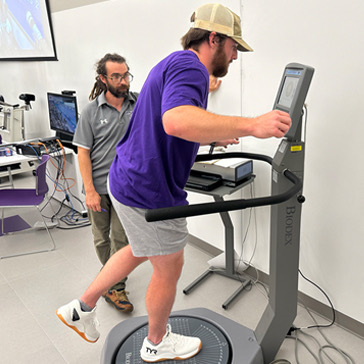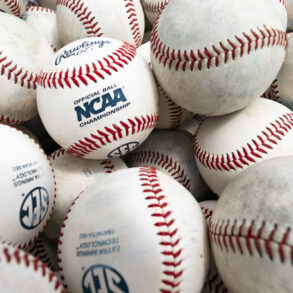
By Matt Vines, Communications Specialist, LSUS Public Relations
LSUS baseball coach Brad Neffendorf thanked a lot of people from the Festival Plaza stage as the Shreveport-Bossier area celebrated the Pilots’ perfect season and NAIA national championship.
There was one person Neffendorf was sure not to forget – LSUS strength and conditioning coach Aaron Adams.
Neffendorf credits Adams’ individualized training plans and specific testing conducted in LSUS’s Human Performance Lab as a key factor in the perfect 59-0 season.
“What he does really meshed well with our intense but shorter practices and how we break up our individual pitching and hitting,” Neffendorf said. “We played faster than everybody else, and we didn’t do conditioning and didn’t run.
“Our conditioning is our practice and our weight training.”
Adams, who also manages the lab, tests all LSUS student-athletes in areas like balance, reaction and their individual body makeup and metabolism.
“The recognition from Neffendorf means a lot because we put a lot of time and effort into the baseball team this year,” Adams said. “Guys would come in and do their initial tests in the lab in the fall, and then we would do interventions in the gym based on those tests results.
“Baseball is such a numbers game, and if a guy can go from a .300 batting average to a .310 or .315, those little bits matter. Metrics like swing velocity and reaction speed – these guys just kept getting better throughout the season.”
Student-athletes regularly retest in the lab to measure how well interventions are working.
“Back in the day, baserunners would freeze on a line drive, but now we want them to get back to the bag immediately,” Neffendorf said. “Last year two of our better players we’re always slow in getting back.
“Well we go check their reaction times in this testing, and it’s bad. Now players can work on these things and improve specifically in these areas.”
Neffendorf added that balance testing helps identify problems with batters and pitchers when previously mechanics or other related items would have been considered the issue.
Adams also encourages coaches to allow teams to lift more often throughout their active seasons than most coaches typically feel comfortable.
Adams said buy-in from players and coaches in all sports has been crucial, even if players perhaps complained a little.
“We’ve gotten buy-in for year-round training, and that doesn’t happen very much at the NAIA level,” Adams said. “Players showed up for every session, even if guys sometimes said, “We’re doing this again?
“(NAIA Pitcher of the Year) Isaac Rohde is a perfect example. He wasn’t always thrilled with the wrist curls, the squats, the lunges – but his arm and his body held up through the entire season, and he went 16-0 with six complete games.”
Both Neffendorf and Adams said players kept fresher legs throughout a long season, and Neffendorf credits this factor with why his pitchers were able to pitch on short rest when needed.
The most prominent example is Rohde’s performance in the NAIA regional, pitching six innings with two runs allowed on May 12 and unexpectedly returning for 4 2/3 scoreless innings on May 14.
“I can tell you nobody was complaining by the end of the year,” Neffendorf said.
Health is another key factor in a great athletics season, and Adams said strength training played a huge role in injury prevention across the LSUS athletics landscape.
“We didn’t have issues with things like knees or shoulders or hamstrings,” Adams said. “One thing that we do is treat new players like they’ve never lifted weights before, teach them how to do it appropriately and then build up to forces that they’ll never experience on the fields of play.”
Neffendorf added that every team that faced late in the season was dealing with three or four major injuries, and the only serious injury on LSUS’s team was a recurring injury suffered before the player’s time in Shreveport.
Adams wants to share these scientifically-proven weightlifting and strength and conditioning practices with the Shreveport-Bossier public.
He’s holding a discussion about youth sports on Tuesday as part of LSUS’s series “Talks on Tap” at Great Raft Brewing Co. The discussion begins at 6 p.m. and will delve into kids playing multiple sports and the impact of simple strength training.
“The biggest thing is let them play – exercise doesn’t have to be ‘exercise’ – just let them play,” said Adams, who competed for and learned from Dr. Kyle Pierce, the longtime LSUS weightlifting coach and member of the International Weightlifting Hall of Fame. “Allow them to learn the movements, and then we can add a little weight based on their age.
“Kids shouldn’t be playing one sport year-round. If you’re throwing a baseball year-round, then you need to add an opposite motion for your shoulder like rowing. Allowing kids to move in different ways throughout multiple sports will strengthen more areas and lead to healthier bodies.”
Want to learn more about high school athletes who underwent testing at the LSUS Human Performance Lab? Read a story from 2024 with more details.
This post was originally published on this site be sure to check out more of their content.






